- Home
- Jean M. Auel
The Land of Painted Caves ec-6
The Land of Painted Caves ec-6 Read online
The Land of Painted Caves
( Earth Children - 6 )
Jean M. Auel
Thirty thousand years in the making and 31 years in the writing, Auel's overlong and underplotted sixth and final volume in the Earth's Children series (The Clan of the Cave Bear; etc.) finds Cro-Magnon Ayla; her mate, Jondalar; and their infant daughter, Jonayla, settling in with the clan of the Ninth Cave of the Zelandonaii. Animal whisperer and medicine woman Ayla is an acolyte in training to become a full-fledged Zelandoni (shaman) of the clan, but all is not rosy in this Ice Age setting; there are wild animals to face and earthquakes to survive, as well as a hunter named Balderan, who has targeted Ayla for death, and a potential cave-wrecker named Marona. While gazing on an elaborate cave painting (presumably, the Lascaux caverns in France), Ayla has an epiphany and invents the concept of art appreciation, and after she overdoses on a hallucinogenic root, Ayla and Jondalar come to understand how much they mean to one another, thus giving birth to another concept — monogamy. Otherwise, not much of dramatic interest happens, and Ayla, for all her superwomanish ways, remains unfortunately flat. Nevertheless, readers who enjoyed the previous volumes will relish the opportunity to re-enter pre-history one last time.
DEDICATION
For RAEANN
First born, last cited, always loved,
and for FRANK,
who stands by her side,
and for AMELIA and BRET, ALECIA, and EMORY,
fine young adults,
with love
Acknowledgments
I am grateful for the assistance of many people who have helped me to write the Earth's Children(r) series. I want to thank again two French archaeologists who have been particularly helpful over the years, Dr. Jean-Philippe Rigaud and Dr. Jean Clottes. They have both enabled me to understand the background and to visualise the prehistoric setting of these books.
Dr. Rigaud's help has been invaluable beginning with my first research visit to France, and his assistance has continued over the years. I particularly enjoyed the visit, which he arranged, to a stone shelter in Gorge d'Enfer, which is still much the way it was in the Ice Age: a deep protected space, open in the front, with a level floor, a rock ceiling and a natural spring at the back. It was easy to see how it could be made into a comfortable place to live. And I appreciated his willingness to explain to reporters and other media people from many countries the interesting and important information about some of the prehistoric sites in and around Les Eyzies de Tayac when Book 5, The Shelters of Stone, was launched internationally from that location in France.
I am also most grateful to Dr. Jean Clottes, who arranged for Ray and me to visit many remarkable painted caves in the south of France. Particularly memorable was the visit to the caves on the property of Comte Robert Begouen in the Volp Valley — l'Enlene, Trois-Freres, and Tuc-d'Audoubert — whose art is often pictured in texts and art books. To actually see some of that remarkable art in its environment, escorted by both Dr. Clottes and Count Begouen, was a treasured experience, and for that thanks in great measure are also due to Robert Begouen. It was his grandfather and two brothers who first explored the caves and began the practice of maintaining them, which continues to this day. No one visits the caves without the permission of Count Begouen, and usually his accompaniment.
We visited many more caves with Dr. Clottes, including Gargas, which is one of my favourites. With its many handprints, including those of a child, and the niche, large enough for an adult to enter, whose inner rock walls are completely covered with a rich red paint using the ochres from the region, I am convinced Gargas is a woman's cave. It feels like the womb of the earth. Above all, I am grateful to Jean Clottes for the visit to the extraordinary Grotte Chauvet. Even though he became too ill with the flu to accompany us, Dr. Clottes arranged for Jean-Marie Chauvet, the man who discovered it and for whom it was named, and Dominique Baffier, curator of Grotte Chauvet, to show us that remarkable site. A young man who was working at the site was also with us and helped me through some of the more difficult parts.
It was a deeply moving experience that I will never forget and I am grateful to both M. Chauvet and Dr. Baffier for their clear and astute explanations. We went in through the ceiling, much enlarged since M. Chauvet and his colleagues first found their way in, and down a ladder that was attached to the rock wall — the original entrance was closed by a landslide many thousands of years ago. They explained some of the changes that have occurred during the past 35,000 years since the first artists made their magnificent paintings.
In addition, I would like to thank Nicholas Conard, an American who lives in Germany and is in charge of the Archaeology Department at the University in Tubingen, for the opportunity to visit several of the Caves along the Danube in that region of Germany. He also showed us several of the ancient carved ivory artifacts that are more than thirty thousand years old, including mammoths, a graceful flying bird that he found in two parts several years apart, and a most amazing lion-human figure. His latest find is a female figure that was created in the same style as others from France, Spain, Austria, Germany, the Czech Republic from the same era, but that is unique in its execution.
I also want to thank Dr. Lawrence Guy Strauss, who has been so willing and helpful in arranging for visits to sites and caves and often accompanying us on several trips to Europe. There were many highlights during those trips, but one of the most interesting was the visit to Abrigo do Lagar Velho, Portugal, the site of the 'lapedo valley child', whose skeleton showed evidence that contact between Neanderthals and anatomically modern humans resulted in interbreeding. The discussions with Dr. Strauss about those Ice Age humans were not only informative, but always fascinating.
I have had discussions and asked questions of many other archaeologists, palaeanthropologists and specialists that I have met, about that particular time in our prehistory, when for many thousands of years both kinds of humans occupied Europe at the same time. I have appreciated their willingness to answer questions and discuss the several possibilities of how they lived.
I want to give special thanks to the French Ministry of Culture for the publication of a book, which I found invaluable: L'Art des Cavernes: Atlas des Grottes Ornees Paleolithiques Francaises, Paris, 1984, Ministere de la Culture. It contains very complete descriptions, including the floor plans, photographs, and drawings, as well as an explanatory narrative of most of the known painted and engraved caves in France, as of 1984. It does not include Cosquer, whose entrance is below the surface of the Mediterranean, or Chauvet, neither of which were discovered until after 1990.
I have visited many caves, so many times, and I can remember the ambiance, the mood, the feeling of seeing exceptional art painted on the walls inside caves, but I couldn't recall precisely what the first figure was, or on which wall it appeared, how far into the cave it was, or what direction it was facing. This book gave me the answers. The only problem was that it was published in French, of course, and while I have learned some French over the years, my command of the language is far from adequate.
So I am deeply indebted to my friend, Claudine Fisher, Honorary French Consul for Oregon, French Professor and Director of Canadian Studies at Portland State University. She is a native speaker who was born in France and she translated all the information I needed of every cave I wanted. It was a lot of work, but without her help, I could not have written this book, and I am more grateful than I can begin to express. She has been helpful in many other ways, too, besides just being a good friend.
There are several other friends I'd like to thank for their willingness to read a long and not-quite-polished manuscript, and make comments as readers: Karen Auel-Feuer, Kendall Auel,
Cathy Humble, Deanna Sterett, Gin DeCamp, Claudine Fisher, and Ray Auel.
I want to offer gratitude in memoriam, to Dr. Jan Jelinek, who was an archaeologist from Czechoslovakia, now known as Czech Republic, who helped me in many ways. From the beginning when we first exchanged letters, and then visits that Ray and I made to see the palaeolithic sites near Brno, and then his and his wife's (Kveta) trip to Oregon. His help was invaluable. He was always kind, and generous with his time and knowledge, and I miss him.
I am lucky to have Betty Prashker as my editor. Her comments are always insightful, and she takes my best efforts and makes them better. Thank you.
Gratitude always to the one who has been there from the beginning, my wonderful literary agent, Jean Naggar. With every book, I appreciate her more. I also want to thank Jennifer Weltz, Jean's partner at the Jean V. Naggar Literary Agency. They continue to perform miracles with this series, which is translated into many foreign languages and available all over the world.
For the past nineteen years Delores Rooney Pander has been my secretary and personal assistant. Unfortunately, she has become ill and has retired, but I want to thank her for her many years of service. You don't really know how much you count on someone like that until she is gone. I miss more than the work she did for me, I miss our conversations and discussions. Over the years she became a good friend.
And most of all, for Ray, my husband, who is always there for me. Love and gratitude beyond measure.
Chapter 1
The band of travellers walked along the path between the clear sparkling water of Grass River and the black-streaked white limestone cliff, following the trail that paralleled the right bank. They went single file around the bend where the stone wall jutted out closer to the water's edge. Ahead a smaller path split off at an angle toward the crossing place, where the flowing water spread out and became shallower, bubbling around exposed rocks.
Before they reached the fork in the trail, a young woman near the front suddenly stopped, her eyes opening wide as she stood perfectly still, staring ahead. She pointed with her chin, not wanting to move. 'Look! Over there!' she said in a hissing whisper of fear. 'Lions!'
Joharran, the leader, lifted his arm, signalling the band to a halt. Just beyond the place where the trail diverged, they now saw pale-tawny cave lions moving around in the grass. The grass was such effective camouflage, however, that they might not have noticed them until they were much closer, if it hadn't been for the sharp eyes of Thefona. The young woman from the Third Cave had exceptionally good vision, and though she was quite young, she was noted for her ability to see far and well. Her innate talent had been recognised early and they had begun training her when she was a small girl; she was their best lookout.
Near the back of the group, walking in front of three horses, Ayla and Jondalar looked up to see what was causing the delay. 'I wonder why we've stopped,' Jondalar said, a familiar frown of worry wrinkling his forehead.
Ayla observed the leader and the people around him closely, and instinctively moved her hand to shield the warm bundle that she carried in the soft leather blanket tied to her chest. Jonayla had recently nursed and was sleeping, but moved slightly at her mother's touch. Ayla had an uncanny ability to interpret meaning from body language, learned young when she lived with the Clan. She knew Joharran was alarmed and Thefona was frightened.
Ayla, too, had extraordinarily sharp vision. She could also pick up sounds above the range of normal hearing and feel the deep tones of those that were below. Her sense of smell and taste were also keen, but she had never compared herself with anyone, and didn't realise how extraordinary her perceptions were. She was born with heightened acuity in all her senses, which no doubt contributed to her survival after losing her parents and everything she knew at five years. Her only training had come from herself. She had developed her natural abilities during the years she studied animals, chiefly carnivores, when she was teaching herself to hunt.
In the stillness, she discerned the faint but familiar rumblings of lions, detected their distinctive scent on a slight breeze, and noticed that several people in front of the group were gazing ahead. When she looked, she saw something move. Suddenly the cats hidden by the grass seemed to jump into clear focus. She could make out two young and three or four adult cave lions. As she started moving forward, she reached with one hand for her spear-thrower, fastened to a carrying loop on her belt, and with the other for a spear from the holder hanging on her back.
'Where are you going?' Jondalar asked.
She stopped. 'There are lions up ahead just beyond the split in the trail,' she said under her breath.
Jondalar turned to look, and noticed movement that he interpreted as lions now that he knew what to look for. He reached for his weapons as well. 'You should stay here with Jonayla. I'll go.'
Ayla glanced down at her sleeping baby, then looked up at him. 'You're good with the spear-thrower, Jondalar, but there are at least two cubs and three grown lions, probably more. If the lions think the cubs are in danger and decide to attack, you'll need help, someone to back you up, and you know I'm better than anyone, except you.'
His brow furrowed again as he paused to think, looking at her. Then he nodded. 'All right … but stay behind me.' He detected movement out of the corner of his eye and glanced back. 'What about the horses?'
'They know lions are near. Look at them,' Ayla said.
Jondalar looked. All three horses, including the new young filly, were staring ahead, obviously aware of the huge felines. Jondalar frowned again. 'Will they be all right? Especially little Grey?'
'They know to stay out of the way of those lions, but I don't see Wolf,' Ayla said. 'I'd better whistle for him.'
'You don't have to,' Jondalar said, pointing in a different direction. 'He must sense something, too. Look at him coming.'
Ayla turned and saw a wolf racing toward her. The canine was a magnificent animal, larger than most, but an injury from a fight with other wolves that left him with a bent ear gave him a rakish look. She made the special signal that she used when they hunted together. He knew it meant to stay near and pay close attention to her. They ducked around people as they hurried toward the front, trying not to cause any undue commotion, and to remain as inconspicuous as possible.
'I'm glad you're here,' Joharran said softly when he saw his brother and Ayla with the wolf quietly appear with their spear-throwers in hand.
'Do you know how many there are?' Ayla asked.
'More than I thought,' Thefona said, trying to seem calm and not let her fear show. 'When I first saw them, I thought there were maybe three or four, but they are moving around in the grass, and now I think there may be ten or more. It's a big pride.'
'And they are feeling confident,' Joharran said.
'How do you know that?' Thefona asked.
'They're ignoring us.'
Jondalar knew his mate was very familiar with the huge felines. 'Ayla knows cave lions,' he said, 'perhaps we should ask her what she thinks.' Joharran nodded in her direction, asking the question silently.
'Joharran is right. They know we're here. And they know how many they are and how many we are,' Ayla said, then added, 'They may see us as something like a herd of horses or aurochs and think they may be able to single out a weak one. I think they are new to this region.'
'What makes you think so?' Joharran said. He was always surprised at Ayla's wealth of knowledge of four-legged hunters, but for some reason it was also at times like this that he noticed her unusual accent more.
'They don't know us, that's why they're so confident,' Ayla continued. 'If they were a resident pride that lived around people and had been chased or hunted a few times, I don't think they would be so unconcerned.'
'Well, maybe we should give them something to be concerned about,' Jondalar said.
Joharran's brow wrinkled in a way that was so much like his taller though younger brother's, it made Ayla want to smile, but it usually showed at a time when smiling
would be inappropriate. 'Perhaps it would be wiser just to avoid them,' the dark-haired leader said.
'I don't think so,' Ayla said, bowing her head and looking down. It was still difficult for her to disagree with a man in public, especially a leader. Though she knew it was perfectly acceptable among the Zelandonii — after all, some leaders were women, including, at one time, Joharran's and Jondalar's mother — such behaviour from a woman would not have been tolerated in the Clan, the ones who raised her.
'Why not?' Joharran asked, his frown turning into a scowl.
'Those lions are resting too close to the home of the Third Cave,' Ayla said quietly. 'There will always be lions around, but if they are comfortable here, they might think of it as a place to return when they want to rest, and would see any people who come near as prey, especially children or elders. They could be a danger to the people who live at Two Rivers Rock, and the other nearby Caves, including the Ninth.'
Joharran took a deep breath, then looked at his fair-haired brother. 'Your mate is right, and you as well, Jondalar. Perhaps now is the time to let those lions know they are not welcome to settle down so close to our homes.'
'This would be a good time to use spear-throwers so we can hunt from a safer distance. Several hunters here have been practising,' Jondalar said. It was for just this sort of thing that he had wanted to come home and show everyone the weapon he had developed. 'We may not even have to kill one, just injure a couple to teach them to stay away.'
'Jondalar,' Ayla said, softly. Now she was getting ready to differ with him, or at least to make a point that he should consider. She looked down again, then raised her eyes and looked directly at him. She wasn't afraid to speak her mind to him, but she wanted to be respectful. 'It's true that a spear-thrower is a very good weapon. With it, a spear can be thrown from a much greater distance than one thrown by hand, and that makes it safer. But safer is not safe. A wounded animal is unpredictable. And one with the strength and speed of a cave lion, hurt and wild with pain, could do anything. If you decide to use these weapons against those lions, they should not be used to injure, but to kill.'

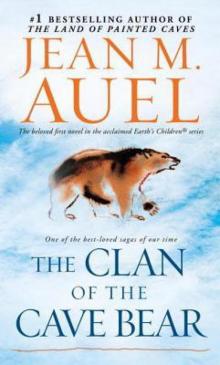 The Clan of the Cave Bear
The Clan of the Cave Bear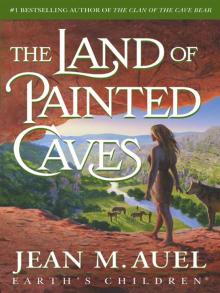 The Land of Painted Caves
The Land of Painted Caves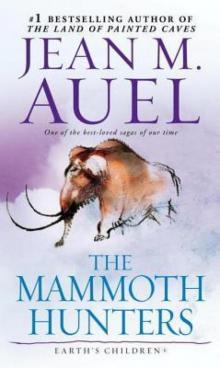 The Mammoth Hunters
The Mammoth Hunters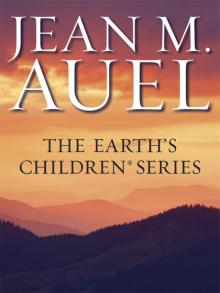 The Earth's Children Series 6-Book Bundle
The Earth's Children Series 6-Book Bundle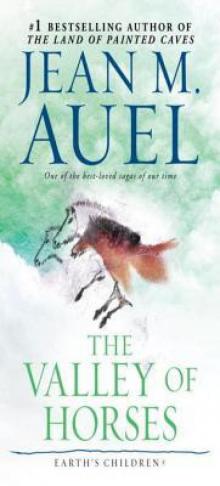 The Valley of Horses
The Valley of Horses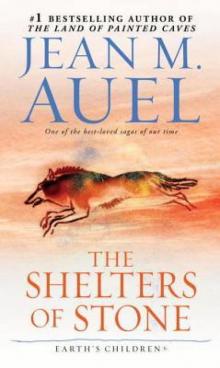 The Shelters of Stone
The Shelters of Stone The Clan of the Cave Bear ec-1
The Clan of the Cave Bear ec-1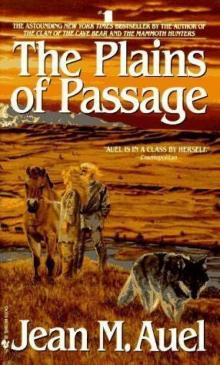 THE PLAINS OF PASSAGE ec-4
THE PLAINS OF PASSAGE ec-4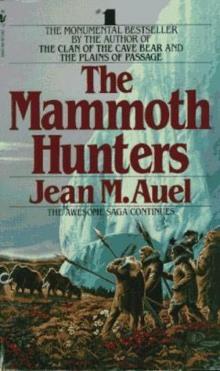 The Mammoth Hunters ec-3
The Mammoth Hunters ec-3 THE SHELTERS OF STONE ec-5
THE SHELTERS OF STONE ec-5 Les refuges de pierre
Les refuges de pierre![Earth's Children [02] The Valley of Horses Read online](http://i1.bookreadfree.com/i1/03/30/earths_children_02_the_valley_of_horses_preview.jpg) Earth's Children [02] The Valley of Horses
Earth's Children [02] The Valley of Horses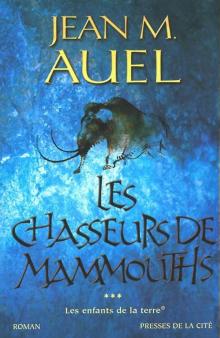 Les chasseurs de mammouths
Les chasseurs de mammouths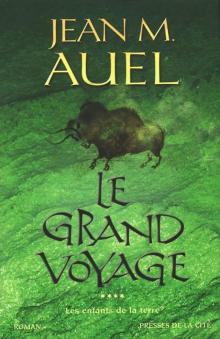 LE GRAND VOYAGE
LE GRAND VOYAGE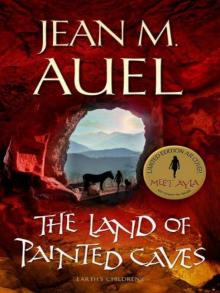 The Land of Painted Caves ec-6
The Land of Painted Caves ec-6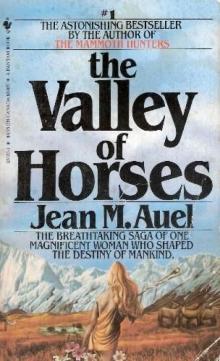 The Valley Of Horses ec-2
The Valley Of Horses ec-2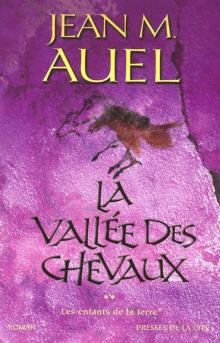 La Vallée des chevaux
La Vallée des chevaux